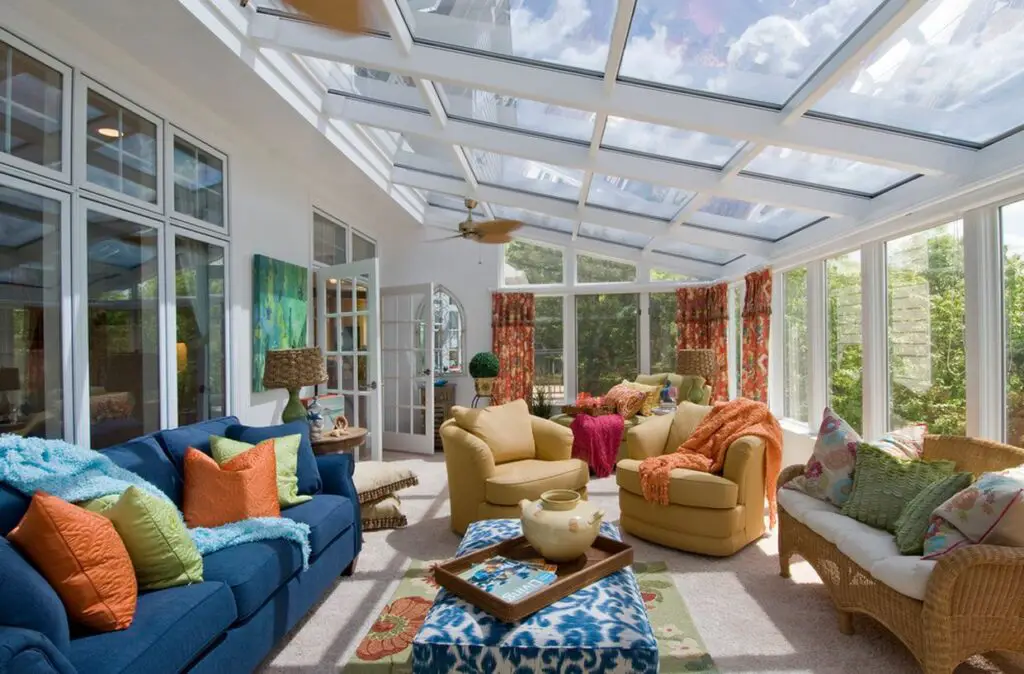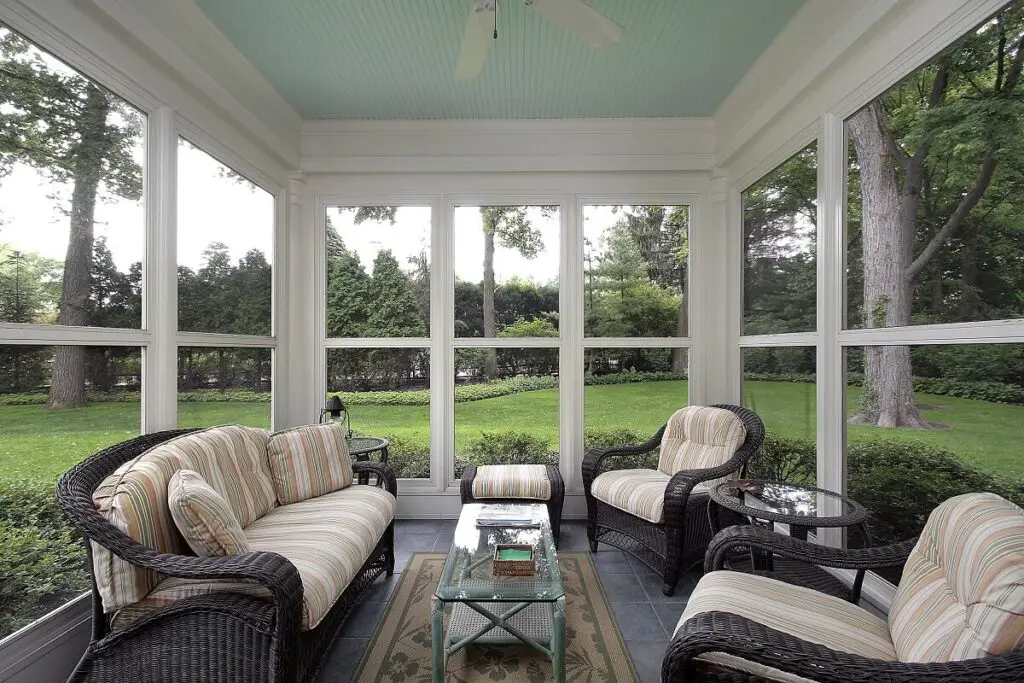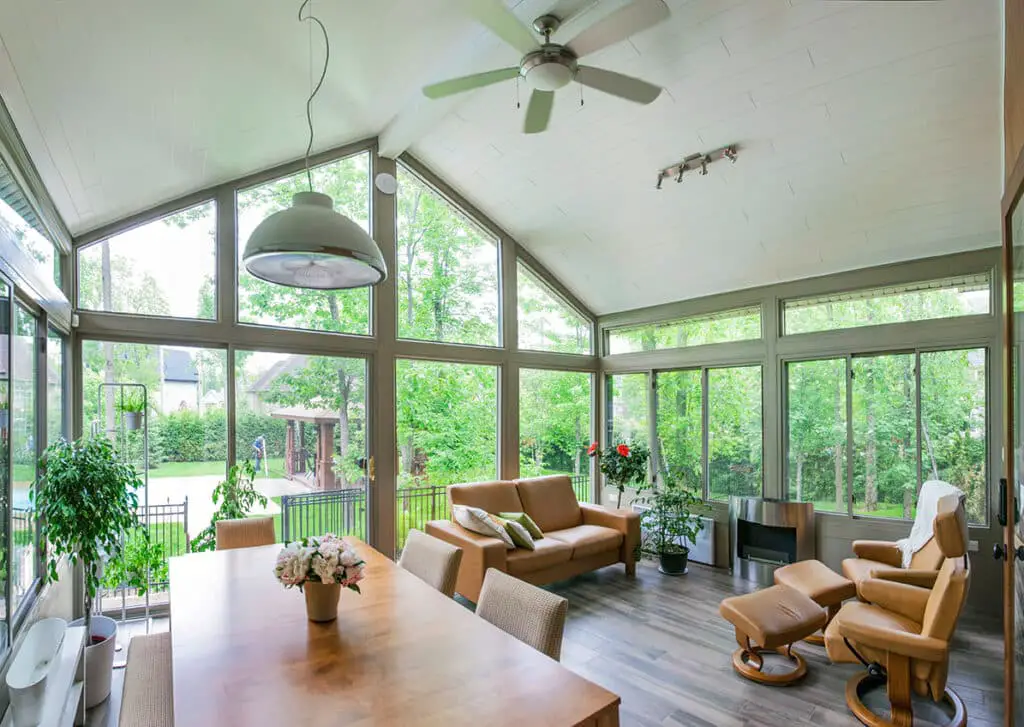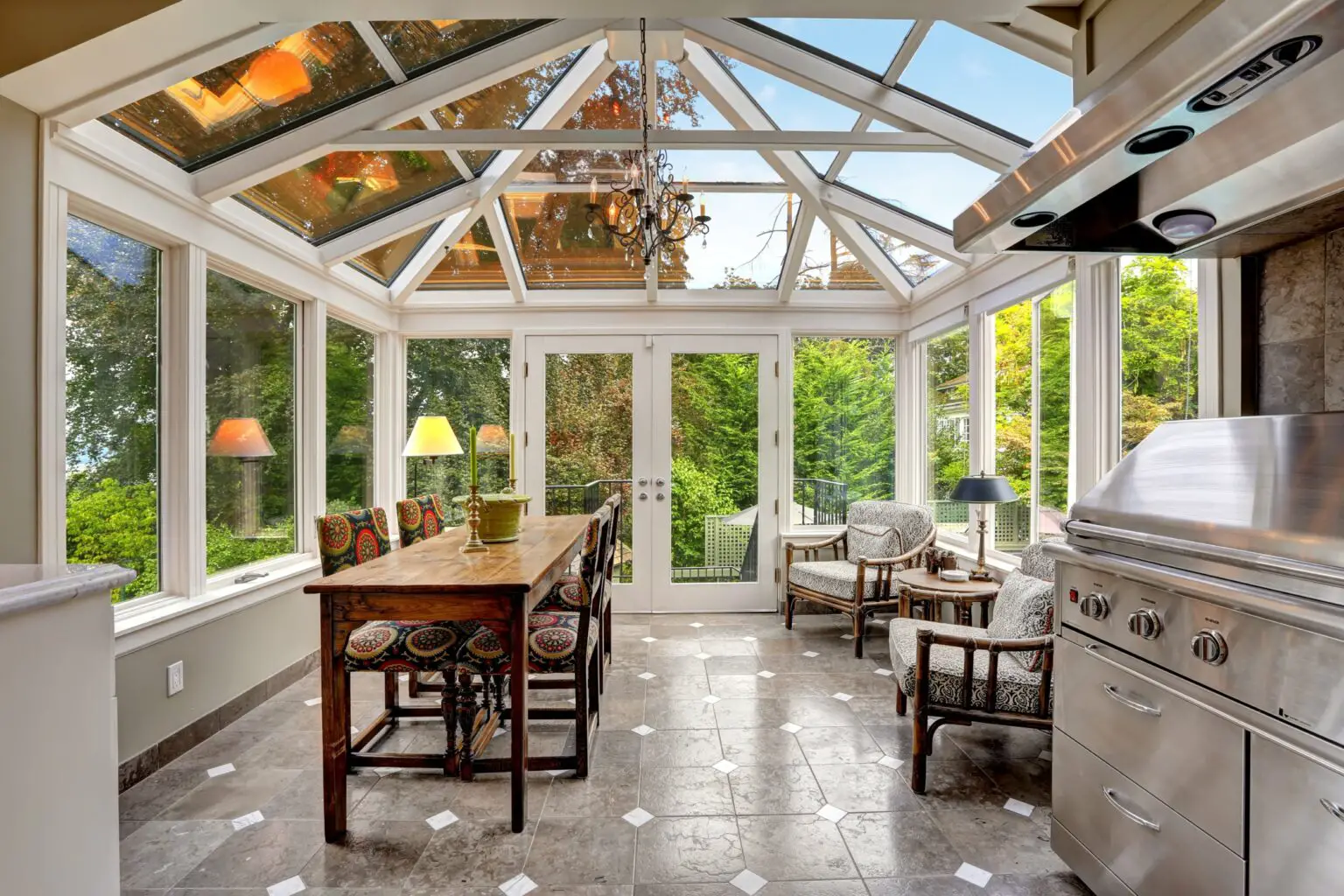How To Build A Sunroom On An Existing Patio
Introduction
How To Build A Sunroom On An Existing Patio: A sunroom can be a great addition, providing a bright and airy space to relax and enjoy the outdoors while still being protected from the elements. And if you already have a patio, you’re one step ahead! Building a sunroom on an existing patio can be a cost-effective and relatively simple way to create the extra space you desire.
First, it’s important to assess the condition of your existing patio. These are crucial factors to consider before proceeding with building a sunroom. If your patio is in good condition, you can move on to the next steps. However, if it’s in need of repairs or reinforcement, it’s essential to address these issues before beginning any construction.
Consider how you plan to use the space. Will it be primarily for relaxation and entertaining, or do you have a specific purpose in mind, such as a home office or a playroom for the kids? This will help determine the size and layout of your sunroom. Additionally, think about block wind the orientation of your patio and how it will affect the amount of sunlight and shade in the room. You may want to consult with a professional to ensure you make the most of your existing patio and create a sunroom that suits your needs and preferences.

How do you build a sunroom from an existing porch?
Building a sunroom from an existing porch can be a great way to add extra living space to your home and enjoy the outdoors all year round. Whether you have a screened-in porch or an open porch, converting it into a sunroom requires careful planning and execution. Here are some steps to help you build a sunroom from an existing porch.
1. Assess the existing porch: Before you begin the conversion process, it’s important to assess the condition and structure of your existing porch. Check for any damage or structural issues that may need to be addressed before proceeding. It’s also important to consider the size and layout of the porch to determine if it can accommodate a sunroom.
2. Determine the design and layout: Once you have assessed the porch, you can start planning the design and layout of your sunroom. Consider factors such as the size of the sunroom, the orientation of the windows, and the type of flooring you want to install. You may also want to think about whether you want to include any additional features such as skylights or a fireplace.
3. Obtain necessary permits: Depending on your location, you may need to obtain permits before you can start building your sunroom. Check with your local building department to find out what permits are required and make sure to obtain them before beginning any construction.
4. Hire a professional or DIY: Building a sunroom from an existing porch can be a complex project, so you may want to consider hiring a professional contractor who specializes in sunroom construction. They will have the expertise and experience to ensure that the conversion is done correctly and meets all building codes. However, if you have the necessary skills and experience, you may choose to tackle the project yourself.
Can you turn a balcony into a sunroom?
Sunrooms are enclosed spaces that offer natural light and outside vistas while protecting from the elements, while balconies are usually attached to buildings. A balcony can become a year-round sunroom by adding windows or glass panels.
When converting a balcony into a sunroom, structural stability is crucial. Balconies may not support windows or glass panels, but they can support people and furnishings. Consult a structural expert or contractor to ensure the balcony can safely sustain the increased weight and stress of enclosing it.
Sunroom design and layout are very important. Sunroom arrangement depends on balcony size and shape. Consider how the sunroom will be utilized and what features you want, such as seats, storage, or lighting.
When converting a balcony into a sunroom, it is also important to consider the local building codes and regulations. Some areas may have specific requirements for enclosing balconies or adding windows. It is important to obtain any necessary permits and ensure that the construction meets all safety and building code requirements.
How do you enclose a patio cheaply?
A patio enclosure can expand your living space and provide a cozy outdoor spot you can use year-round. Enclosing a patio can be expensive, especially if you use high-end materials and professional installation. There are various inexpensive patio enclosure choices.
Outdoor drapes or shades are a cheap method to enclose a patio. These are easy to install and give privacy and weather protection. Outdoor curtains come in several materials and styles, so you may choose one that meets your demands and style. Hang them from a rod or wire and open or close them. Outdoor shades are usually constructed of durable cloth or bamboo and may be rolled up or down for shade and privacy.
Lattice panels are another inexpensive patio enclosure option. Wood or vinyl lattice panels can be readily put around your patio. They add style and utility to your patio while letting air and light in. Lattice panels can be painted or stained to match your patio decor and modified to accommodate any size or shape patio.
What is the most affordable patio enclosure?
When it comes to patio enclosures, many people care most about how much they cost. No one wants to spend a lot of money just to have more room to live outside. In that case, what is the least expensive way to cover a patio?
A screened-in porch is one of the most affordable ways to cover your backyard. This kind of shelter usually has a frame with screens that go around the porch. This way, you can enjoy the outdoors without bugs or other pests getting in the way. Most of the time, screened-in porches are cheaper than other types of barriers because they require less work and materials.
A canopy is another inexpensive way to cover your patio. A pergola is a building with an open roof that is held up by beams or posts. A pergola doesn’t protect you from the weather as well as a fully covered patio, but it can still help you define your outdoor space and give you some shade. Because they take less time and materials to build, pergolas are usually cheaper than fully covered patio enclosures.
If you want to save money, you might want to think about a temporary yard enclosure. These enclosures are usually made of light materials like cloth or plastic, and they are simple to put together and take down when needed. Even though temporary enclosures might not last as long or guard as well as permanent structures, they can save you money if you are short on cash.

How do I make my patio enclosed?
There are several ways to make your patio enclosed, depending on your preferences and budget. Whether you want to create a cozy outdoor living space or simply add some privacy to your patio, there are options available to suit your needs. In this article, we will explore some popular methods for enclosing a patio.
One option is to install a patio cover or pergola. This can provide shade and protection from the elements, making your patio feel more like an extension of your home. Patio covers can be made from a variety of materials, including wood, aluminum, and vinyl. They can be attached to the side of your house or freestanding, depending on your space and design preferences. Pergolas are similar to patio covers but typically have an open roof structure, allowing for more sunlight and airflow.
Another option is to use outdoor curtains or blinds. These can be hung from a pergola or other structure to create a sense of enclosure and privacy. Outdoor curtains are typically made from weather-resistant fabric and can be easily opened or closed as needed. Outdoor blinds are a more permanent solution and can be made from materials such as bamboo or vinyl. They can be rolled up or down to control the amount of sunlight and privacy.
If you want a more permanent enclosure, you could consider installing glass or screen walls. Glass walls can provide a sleek and modern look while still allowing for natural light. They can be framed or frameless, depending on your aesthetic preferences. Screen walls are a more affordable option and can help keep out bugs and debris while still allowing for airflow. They can be made from materials such as aluminum or fiberglass and can be installed as a permanent structure or as removable panels.
Building a sunroom on an existing patio requires careful planning and execution. Here are the necessary steps to successfully complete this project
1. Assess the existing patio: Before starting the construction, evaluate the condition and suitability of the existing patio. Ensure that it is structurally sound and can support the additional weight of the sunroom. Consider factors such as the size, orientation, and accessibility of the patio.
2. Design the sunroom: Determine the size, shape, and layout of the sunroom based on your needs and preferences. Consider factors such as the amount of sunlight desired, the purpose of the sunroom, and any specific features or amenities you want to incorporate.
3. Obtain necessary permits: Check with your local building department to determine if any permits or regulations apply to the construction of a sunroom. Obtain the required permits and ensure compliance with all building codes and regulations.
What materials and tools are required for constructing a sunroom on an existing patio?
Building a sunroom on an existing patio requires numerous materials and tools. Lumber, concrete, insulation, and roofing components are needed first. These components will build your sunroom’s base, walls, and roof, giving structure and weatherproofing.
Construction requires building materials and various tools. Tools like a measuring tape, level, hammer, screwdriver, drill, saw, and ladder are necessary. Measure and cut items, secure them, and level everything with these tools.
Your sunroom’s design, size, and desired features and amenities will determine the materials and tools needed. You should consult an expert or perform careful research to ensure you have all the materials and tools for your job.
Are there any specific permits or regulations that need to be considered when building a sunroom on an existing patio?
When building a sunroom on an existing patio, it is important to consider any specific permits or regulations that may be required. The requirements can vary depending on your location and the specific details of your project, so it is essential to check with your local building department or zoning board to ensure compliance.
In many areas, adding a sunroom to an existing patio may require a building permit. This permit is typically necessary to ensure that the construction meets safety and building code standards. The permit process may involve submitting detailed plans and specifications for the sunroom, as well as paying a fee. It is important to note that proceeding without the necessary permits can result in fines or even having to remove the sunroom.
How can the existing patio be prepared or modified to accommodate the construction of a sunroom?
Preparing the existing patio is an important step in building a sunroom. The first thing to consider is the condition of the patio. It should be in good shape and free from any cracks or damage. If there are any issues, they should be repaired before starting the construction. This may involve patching up cracks, replacing damaged sections, or even resurfacing the entire patio.
Once the patio is in good condition, it may need to be modified to accommodate the construction of a sunroom. This can involve several steps. One common modification is to extend the patio to create a larger space for the sunroom. This may require removing a section of the existing patio and pouring new concrete to create the desired size and shape. Another modification may involve adding additional support or reinforcement to the patio to ensure it can handle the weight of the sunroom. This may involve installing additional footings or reinforcing the existing ones.
Are there any recommended design considerations or features to incorporate when building a sunroom on an existing patio?
Building a sunroom on an existing patio requires various architectural considerations and amenities to improve its functionality and appearance. Sunroom orientation matters in design. The sunroom should be oriented to maximize natural light and views. This can be done with big windows or floor-to-ceiling glass walls. Additionally, local climate and weather are important. Proper insulation, ventilation, and shading may keep the sunroom comfortable year-round.
Flooring material is another design factor. Since the sunroom will be exposed to sunlight, wetness, and foot activity, durable, low-maintenance flooring is vital. Ceramic tiles, vinyl planks, and tinted concrete are popular. A skylight or vaulted ceiling can also make the sunroom feel larger and more inviting. Finally, the sunroom’s purpose should guide layout and furnishings selection. Whether the sunroom will be a dining room, lounge, or home office, choosing the right furniture and accessories will improve its functionality and comfort.

Conclusion
Building a sunroom on an existing patio can be a great way to add extra living space to your home and enjoy the outdoors all year round. Whether you want to create a cozy reading nook, a home office, or a space for entertaining guests, a sunroom can provide the perfect solution. However, the process of building a sunroom on an existing patio can be quite complex and requires careful planning and execution.
Firstly, it is important to assess the condition of your existing patio. Make sure that it is structurally sound and can support the additional weight of a sunroom. If necessary, reinforce the patio or make any necessary repairs before proceeding with the construction. It is also important to consider the orientation of the sunroom and how it will fit into the overall design of your home.
Secondly, you will need to decide on the type of sunroom you want to build. There are several options to choose from, including three-season sunrooms, four-season sunrooms, and solariums. Each type has its own advantages and considerations, so it is important to research and determine which one best suits your needs and budget. Next, you will need to obtain any necessary permits and approvals from your local building department. Building codes and regulations vary from place to place, so it is important to ensure that your sunroom meets all the necessary requirements. This may involve submitting detailed plans and specifications to the building department for review.








